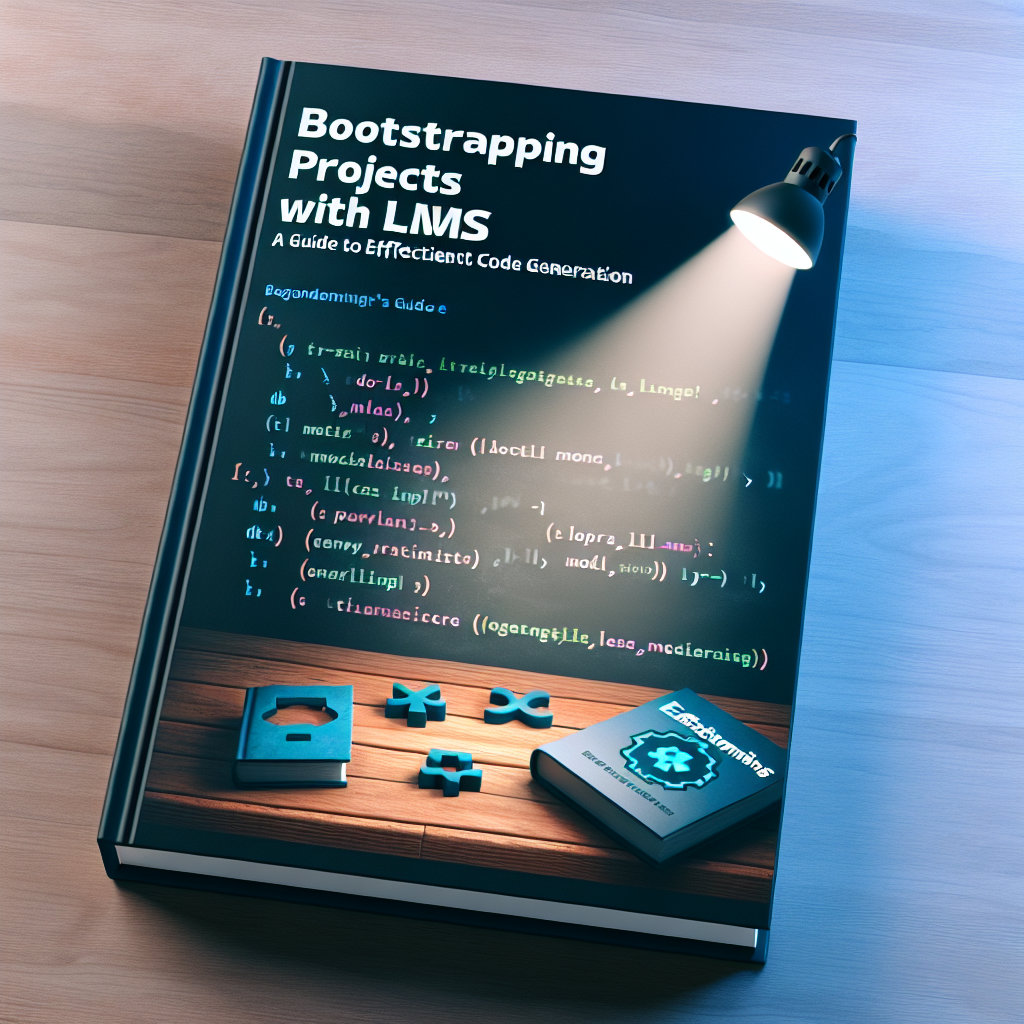Bootstrapping Projects with LLMs: Unleashing the Power of AI-Driven Code Generation
Imagine kickstarting your next software project with the help of an AI assistant that can write code, design architectures, and even predict your next line of thought. Sounds like science fiction? Welcome to the world of Large Language Models (LLMs) and their game-changing impact on software development.
In this guide, we’ll dive deep into how LLMs are revolutionizing the way developers bootstrap projects, offering a blend of efficiency, creativity, and technical prowess that was once the stuff of dreams. Whether you’re a seasoned coder or a curious novice, get ready to explore the exciting frontier where artificial intelligence meets software engineering.
Executive Summary
LLMs have emerged as powerful allies in the software development process, offering rapid prototyping, reduced boilerplate code, and assistance with complex algorithms. This guide explores the benefits, best practices, tools, and ethical considerations of using LLMs for code generation. We’ll cover everything from crafting effective prompts to integrating AI-generated code into your workflow, helping you navigate this new landscape with confidence and skill.
Introduction to LLMs and Code Generation
Large Language Models, such as GPT-3 and its successors, have transcended their original purpose of natural language processing to become versatile tools in the programmer’s toolkit. These AI marvels can understand context, generate human-like text, and most importantly for us, write code across various programming languages and frameworks.
The beauty of LLMs lies in their adaptability. Whether you’re working on a web application, mobile app, or complex data analysis project, these models can assist you in generating code snippets, entire functions, or even complete project structures. It’s like having a hyper-intelligent IDE that not only autocompletes your code but also understands your intent and can translate it into working software.
Mastering the Art of Prompt Engineering
To harness the full potential of LLMs for code generation, you need to become adept at prompt engineering. Think of it as learning to communicate effectively with an incredibly smart, but sometimes literal-minded, coding partner.
Here’s an example of an effective prompt:
Language: Python
Framework: Flask
Task: Create a basic route for a user registration API endpoint
Requirements:
- Accept POST requests with JSON payload
- Validate email and password fields
- Return appropriate HTTP status codes
- Follow PEP 8 style guidelines
This prompt is specific, clear, and provides all the necessary context for the LLM to generate relevant code. Let’s break down the key elements of effective prompts:
- Specify the language and framework: This immediately sets the context for the code generation.
- Clearly define the task: Be explicit about what you want the code to accomplish.
- List specific requirements: This helps the LLM understand the constraints and expected functionality.
- Mention coding standards: This ensures the generated code aligns with your project’s style guidelines.
Remember, the more specific and detailed your prompt, the better the output you’ll receive. It’s a skill that improves with practice, so don’t be afraid to experiment and refine your prompts over time.
Tools of the Trade: LLM-Powered Development Platforms
The landscape of LLM-powered development tools is rapidly evolving. Here are some of the leading platforms and what makes them stand out:
- GitHub Copilot: Integrated directly into your IDE, Copilot offers real-time code suggestions as you type. It’s like having a pair programmer who can read your mind.
- OpenAI Codex: The engine behind Copilot, Codex offers a powerful API for developers who want to build their own code generation tools or integrate AI capabilities into existing workflows.
- Tabnine: Known for its privacy-focused approach, Tabnine offers both cloud-based and self-hosted options, making it a great choice for organizations with strict data security requirements.
- Replit’s Ghostwriter: Built into the Replit online IDE, Ghostwriter offers code completion, explanation, and even debugging assistance, making it an excellent tool for both learning and rapid prototyping.
Each of these tools has its strengths, and the best choice depends on your specific needs, workflow, and privacy considerations. Many developers find value in using a combination of these tools to cover different aspects of their development process.
Navigating the Limitations and Challenges
While LLMs are powerful allies in code generation, they’re not without their quirks and limitations. Here’s a rundown of the challenges you might face and how to address them:
- Code Quality: LLM-generated code can sometimes be verbose or suboptimal. Solution: Always review and refactor the generated code. Use it as a starting point rather than a final product.
- Security Concerns: AI might inadvertently introduce vulnerabilities, especially in security-critical sections. Solution: Implement rigorous code review processes and use automated security scanning tools as part of your CI/CD pipeline.
- Training Data Limitations: LLMs can only generate code based on their training data, which may not include the latest frameworks or best practices. Solution: Stay informed about the model’s capabilities and limitations, and be prepared to supplement with your own knowledge.
- Licensing Issues: There’s ongoing debate about the copyright status of AI-generated code. Solution: Familiarize yourself with the licensing terms of the LLM tool you’re using, and when in doubt, treat the generated code as you would any third-party code, ensuring proper attribution and compliance with your project’s licensing requirements.
By being aware of these challenges and implementing appropriate safeguards, you can maximize the benefits of LLM-powered code generation while minimizing potential risks.
Real-World Success: Case Studies in Project Bootstrapping
Let’s look at how real developers are leveraging LLMs to supercharge their project initiation:
Web Application Framework Wizardry
Sarah, a full-stack developer, was tasked with creating a new e-commerce platform from scratch. Using GPT-4 through GitHub Copilot, she generated the initial project structure, including routing logic, authentication middleware, and database schema definitions for a Node.js and Express.js backend.
Key Prompts Used:
– “Create an Express.js server with basic routing for an e-commerce platform”
– “Generate a user authentication middleware using JWT”
– “Design a MongoDB schema for product catalog and user orders”
Results:
– Initial setup time reduced from 2 days to 4 hours
– Generated code covered 70% of the basic functionality, requiring only minor adjustments
– Sarah could focus on implementing complex business logic and unique features earlier in the development cycle
API Development Acceleration
A team at a fintech startup used OpenAI’s Codex to bootstrap their microservices architecture. They leveraged the AI to generate OpenAPI specifications, server stubs, and even basic unit tests for their core services.
Key Strategies:
– Used natural language descriptions to generate initial API specs
– Iteratively refined the generated code through specific prompts addressing edge cases and error handling
– Employed AI-generated unit tests as a starting point for more comprehensive test coverage
Outcomes:
– API development time cut by 40%
– Improved consistency across microservices due to standardized AI-generated boilerplate
– Earlier detection of potential issues through AI-assisted test generation
These case studies highlight the transformative potential of LLMs in real-world development scenarios. The key takeaway is that AI serves as a powerful accelerator, allowing developers to focus on high-value tasks and creative problem-solving.
Ethical Considerations and Best Practices
As we embrace the power of AI in code generation, it’s crucial to maintain ethical standards and best practices:
- Understand the Code: Resist the temptation to blindly copy-paste AI-generated code. Take the time to understand how it works and why certain decisions were made.
- Verify and Test: Treat AI-generated code with the same rigor you would apply to code written by a junior developer. Implement thorough testing and code review processes.
- Attribution: When using substantial amounts of AI-generated code, consider adding a note in your documentation or comments acknowledging the use of AI assistance.
- Continuous Learning: Use LLMs as a learning tool. When you encounter interesting code snippets or solutions, take the time to understand the underlying principles and techniques.
- Data Privacy: Be cautious about inputting sensitive information or proprietary code into LLM tools. Always review the privacy policies of the platforms you’re using.
- Bias Awareness: Remember that LLMs can perpetuate biases present in their training data. Be vigilant about identifying and correcting any biased or discriminatory code or comments.
By adhering to these principles, we can harness the power of AI while maintaining the integrity and quality of our software projects.
Conclusion: Embracing the AI-Augmented Future of Development
As we’ve explored in this guide, Large Language Models are not just a fancy new tool in the developer’s toolkit – they represent a paradigm shift in how we approach software creation. From rapid prototyping to solving complex algorithmic challenges, LLMs are enabling developers to work at unprecedented speeds and scales.
However, it’s important to remember that these AI assistants are just that – assistants. They amplify human creativity and problem-solving skills rather than replace them. The most successful developers will be those who learn to dance in step with AI, leveraging its strengths while applying their own expertise, ethical judgment, and innovative thinking.
As you embark on your next project, consider how you might integrate LLM-powered code generation into your workflow. Start small, experiment, and gradually expand your use as you become more comfortable with the technology. The future of coding is here, and it’s more exciting and full of possibilities than ever before.
Remember, in this AI-augmented landscape, your most valuable asset is not just your coding skills, but your ability to ask the right questions, provide clear context, and critically evaluate the results. Happy coding, and may your prompts be ever fruitful!


